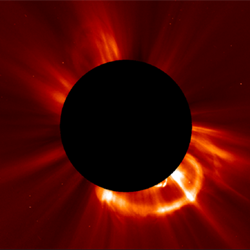Planet Earth and its realm in space provided a broad canvas for research stories painted by this year's SciCom students for the national blog from the American Geophysical Union's fall meeting.
The meeting, held each December in San Francisco, attracts some 20,000 geoscientists to the Moscone Center. AGU invites students from the Science Communication Program to scour the talks and poster sessions each day for stories uncovered by the meeting's large contingent of reporters, many of whom focus on major news briefings.
The results, published in AGU's GeoSpace blog, showcase the work of ten students who just finished courses in reporting science news for national audiences.
Among the stories is a new method for predicting the severity of coronal mass ejections (CMEs): giant blobs of charged gas expelled by the sun. Three-dimensional models created from a sequence of radio images of approaching CMEs could help forecast how strongly they will disrupt Earth's magnetic field—and electrical systems in orbit or on the ground.
Another monitoring effort close to home may lead to real-time detections of gamma-ray flashes from powerful thunderstorms. Researchers believe a smartphone app called GammaPix could trace these elusive bursts if enough people use the app at high altitudes, where such radiation could pose risks.
Scientists running a years-long experiment to test the impacts of higher levels of carbon dioxide in the atmosphere reported their latest work at AGU. Trees within zones of artifically enhanced CO2 grew deeper and finer roots in search of more nitrogen for growth, a team member reported.
In other highlights from the blog:
• A seafloor drone and an extensive network of sensors monitor deep-sea biological, oceanographic, and geophysical conditions off the British Columbia coast.
• Laser and radar measurements from airplanes are revealing zones at high risk for landslides during typhoons and major storms in the Philippines.
• A buoyant lake rover deployed underneath the ice of Arctic lakes is recording methane bubbles and other conditions in areas of melting permafrost.
• New magnetic data has exposed the age of Earth's oldest slab of seafloor, the Ionian basin in the Mediterranean Sea.
• Metabolic and DNA data from hardy cells collected at "serpentinizing seeps" suggest how primitive deep-Earth microbes may use chemical energy to survive.
The two dozen stories written by SciCom students were edited by Nanci Bompey, a public information specialist who joined AGU's news team in October. AGU's press operations at the meeting were run by public information manager Peter Weiss, a 1990 graduate of the Science Communication Program.



